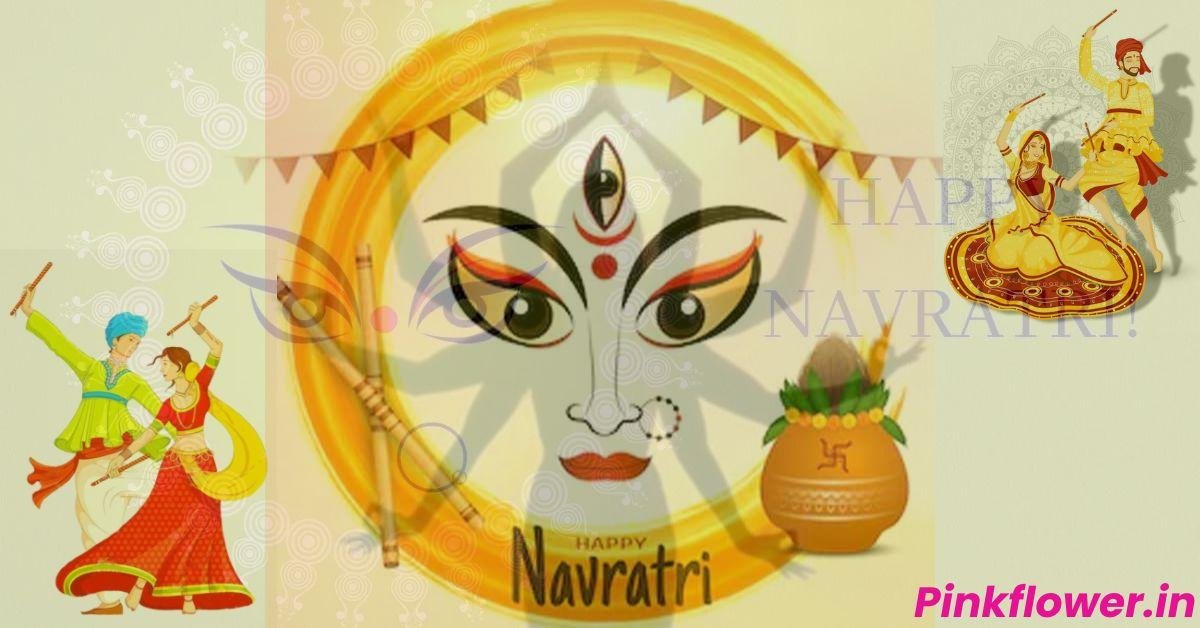
Navratri is a major festival of Hindus. Navratri is a Sanskrit word, which means ‘nine nights’. During these nine nights and ten days, nine forms of Shakti/Devi are worshipped. The tenth day is famous as Dussehra. In Hinduism, major festival held in honour of the divine feminine.
Navratri is often associated with women’s empowerment because Goddess Durga is worshipped. “Durga”, a synonym for women’s empowerment! Power, truth, education, peace, rebelliousness, and a caring mother are considered the attributes of the deity. Navratri means nine nights symbolizing the victory of good over evil, positivity over negativity, compassion over hatred, equality over bias, empowerment over harassment, and many more things.
Navratri comes four times in a year. It is celebrated from Pratipada to Navami in Magh, Chaitra, Ashadh and Ashwin months. During the nine nights of Navratri, nine forms of three goddesses – Mahalakshmi, Mahasaraswati or Saraswati and Mahakali are worshipped, whose names and places are as follows respectively Nanda Devi Yogamaya (Vindhyavasini Shaktipeeth), Raktdantika (Sathoor), Shakambhari (Saharanpur Shaktipeeth), Durga (Kashi), Bhima (Pinjore) and Bhramari (Bhramramba Shaktipeeth) are called Navdurga.
Navratri is an important major festival which is celebrated all over India with great enthusiasm. Navratri is celebrated differently in different parts of India. For many people it is a time of religious reflection and fasting, while for others it is a time for dancing and feasting. Among fasting customs are observing a strict vegetarian diet and abstainin. This festival is celebrated in a big way in Gujarat. Navratri celebrations in Gujarat are known as Dandiya and Garba. It goes on all night long. The experience of Dandiya is extraordinary. Garba, as a devotional performance in honor of the Goddess, is performed before the ‘Aarti’ and followed by the Dandiya ceremony.
Among the main festivals of Bengalis in the state of West Bengal, Durga Puja has emerged in the most ornate form in the Bengali calendar. This marvelous celebration is celebrated by lighting up the majestic quarter of Mysore down south, throughout the month.
Navratri festival is a representation of Goddess Amba (Electricity). The onset of spring and the beginning of autumn are considered to be a significant confluence of the effects of climate and the sun. These two times are considered sacred occasions for the worship of Maa Durga. The festival dates are determined according to the lunar calendar. The Navratri festival is considered to be the most auspicious and unique period of devotion to the concept of Mother-Durga and worship of the divine power (sublime, ultimate, ultimate creative energy).
This worship has been going on since prehistoric times, before the Vedic age. Since the Vedic age of the sages, Gayatri Sadhana has been the main form of devotional practices during Navratri. During Navratri, huge fairs are held on the Shaktipeeths and Siddhapeeths of the Goddess. The importance of all the Shaktipeeths of Mata is different. But the nature of the mother is the same. Somewhere near Jammu Katra becomes Vaishno Devi. So somewhere it is worshiped in Chamunda form. In Bilaspur, Himachal Pradesh, a fair is held for the mother in the name of Naina Devi, while in Saharanpur, a huge fair is held for the mother in the name of Shakumbhari Devi. According to folk beliefs, people wish that the mother is pleased by fasting on the day of Navratri, the provision of fasting is not in the religious texts of Hindu religion.
1. First three days of Navratri :
The first three days of Navratri are dedicated to the worship of Goddess Durga. This puja is done for energy and strength. Each day is dedicated to a different form of Durga. Goddess Shailputri is worshiped on the first day, Brahmacharini on the second day and Chandraghanta form on the third day.
2. Fourth to sixth day of Navratri:
When one has overcome the evil tendencies of ego, anger, lust and other animal instincts, he experiences a void. This void is filled with spiritual wealth. For the purpose, one worships Goddess Lakshmi to attain all materialistic, spiritual wealth and prosperity. The fourth, fifth and sixth days of Navratri are dedicated to the worship of Lakshmi- the goddess of prosperity and peace. Perhaps one has conquered evil tendencies and wealth, but he is still deprived of true knowledge. Knowledge is essential for living a human life even though it is rich with power and wealth. Hence, Goddess Saraswati is worshiped on the fifth day of Navratri. All the books and other literary materials are gathered at one place and a diya is lit in front of the deity to invoke the goddess and seek blessings.
3. Seventh and eighth day of Navratri:
On the seventh day, Saraswati, the goddess of arts and knowledge, is worshipped. Prayers are performed with the aim of seeking spiritual enlightenment. A ‘yagna’ is performed on the eighth day. It is a sacrifice that honors and sends off Goddess Durga.
4. Ninth day of Navratri:
The ninth day is the last day of Navratri. It is also known as Mahanavami. Kanya Puja is done on this day. In which nine girls are worshiped who have not yet reached the stage of puberty. These nine girls are considered to represent the nine forms of Goddess Durga. To honor and welcome the girls, their feet are washed. At the end of the puja new clothes are given to the girls as a gift.
Navratri 2022 – Colours & its Significance
Day 1 – White
White denotes peace and purity.
Day 2 – Red
Red signifies beauty and fearlessness.
Day 3 – Royal blue
Royal blue signifies health and wealth.
Day 4 – Yellow
The colour yellow denotes happiness and brightness.
Day 5 – Green
Green denotes new beginnings and growth.
Day 6 – Grey
Grey signify the strength of transformation.
Day 7 – Orange
Orange signifies energy and happiness.
Day 8 – Peacock green
Peacock green signifies the fulfillment of wishes.
Day 9 – Pink
Pink denotes the power of intellect and peace.




